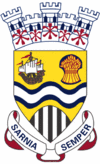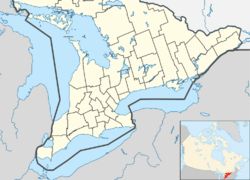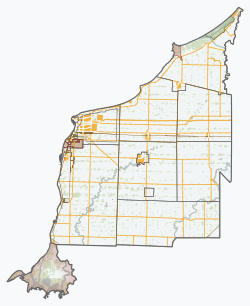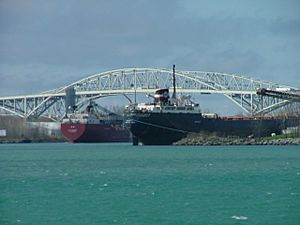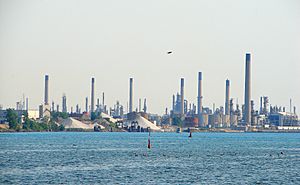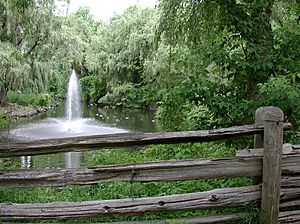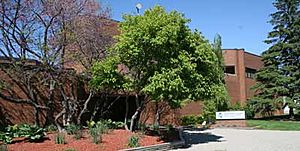Sarnia facts for kids
Quick facts for kids
Sarnia
|
|||
|---|---|---|---|
|
City (lower-tier)
|
|||
| City of Sarnia | |||
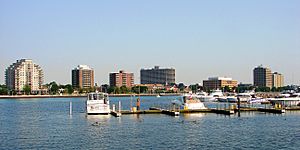 |
|||
|
|||
| Nickname(s):
The Imperial City
|
|||
| Motto(s):
Sarnia Semper
(Latin for "Sarnia Always") |
|||
| Country | Canada | ||
| Province | Ontario | ||
| County | Lambton | ||
| Settled | 1830s | ||
| Incorporated | 19 June 1856 (town) | ||
| Incorporated | 7 May 1914 (city) | ||
| Area | |||
| • City | 163.90 km2 (63.28 sq mi) | ||
| • Metro | 1,118.65 km2 (431.91 sq mi) | ||
| Elevation | 180.60 m (592.52 ft) | ||
| Population
(2021)
|
|||
| • City | 72,047 (83rd) | ||
| • Density | 439.6/km2 (1,139/sq mi) | ||
| • Metro | 97,592 (44th) | ||
| Forward sortation area |
N7S to N7X
|
||
| Area codes | 519, 226 and 548 | ||
Sarnia is a city in Lambton County, Ontario, Canada. In 2021, about 72,047 people lived there. It is the biggest city on Lake Huron. Sarnia is on the eastern side where Lake Huron flows into the St. Clair River. This river forms part of the border between Canada and the United States. Right across the river is Port Huron, Michigan.
Sarnia's natural harbour first caught the eye of French explorer La Salle. In 1679, he named the spot "The Rapids." His ship, Le Griffon, was the first large vessel to sail into Lake Huron. This journey helped start commercial shipping on the Great Lakes. Today, Sarnia's port is still important for ships carrying grain and oil.
The area also has large salt caverns and oil. Oil was found nearby in Oil Springs in 1858. This led to a big growth in the oil industry. Oil Springs was the first place in Canada to drill for oil. People from Sarnia traveled the world to teach others how to drill for oil.
South of downtown Sarnia, there is a large area of oil refineries and chemical companies. This area is known as "Chemical Valley." In 2011, Sarnia had the most air pollution from tiny particles in Canada. But now, it has improved a lot. About 60% of this pollution comes from industries in the United States.
Lake Huron helps keep Sarnia's weather mild. In summer, the lake is cooler than the air. In winter, it is warmer. This means Sarnia does not get extremely hot or cold. In winter, Sarnia sometimes gets a lot of lake-effect snow. This happens when cold air blows over the warmer lake water.
Contents
- Sarnia's Story: A Look at Its History
- Sarnia's Location and Surroundings
- Who Lives in Sarnia?
- Sarnia's Economy: How People Make a Living
- Arts, Culture, and Fun in Sarnia
- Cool Places to Visit in Sarnia
- Sports in Sarnia
- Getting Around Sarnia
- Learning in Sarnia
- News and Media in Sarnia
- Famous People from Sarnia
- See also
Sarnia's Story: A Look at Its History
How Sarnia Got Its Name
The name "Sarnia" comes from the Latin name for Guernsey. Guernsey is a British island. In 1829, Sir John Colborne became the Lieutenant Governor of Upper Canada. He used to be the governor of Guernsey.
In 1835, Sir John Colborne visited two small towns on Lake Huron. One of them was called "The Rapids." The people living there wanted to change its name. But they could not agree on a new one. English settlers liked "Buenos Aires," and Scottish settlers liked "New Glasgow."
Sir John Colborne suggested "Port Sarnia." On January 4, 1836, the people voted and chose this name. Colborne also named a nearby village "Moore." Sarnia got the nickname "The Imperial City" in 1914. This was because Canada's Governor General, the Duke of Connaught, visited.
Early Days of Sarnia
French settlers from Detroit were the first Europeans to live in the Sarnia area. This was around 1807–1810. They were fur traders who worked with the Huron and Three Fires Confederacy Indigenous groups. French Jesuits also built a mission near an Indigenous village. Later, these settlers started farms, which helped the area grow.
The land was officially surveyed in 1829. In the early 1830s, many Scottish immigrants moved to the area. They became the main English-speaking group.
Port Sarnia grew throughout the 1800s. In 1856, it officially became the Town of Sarnia. The area had a big lumber industry. This was because of the many trees around the Great Lakes. Lumber was needed in growing US cities like Chicago and Detroit.
The discovery of oil in nearby Oil Springs in 1858 helped Sarnia grow even more. The Great Western Railway arrived in 1858, and the Grand Trunk Railway in 1859. These railways helped connect Sarnia to other places.
In 1890, the St. Clair Tunnel opened under the St. Clair River. This tunnel connected the railways directly to the United States. It was the first railroad tunnel ever built under a river. Building it was a huge engineering achievement.
Sarnia in the 1900s and Today
Canada Steamship Lines was formed in 1913 from many shipping companies. One of these was the Northwest Transportation Company of Sarnia, started in 1870. By 1914, Sarnia had grown to almost 11,000 people. On May 7, 1914, Sarnia officially became a city.
Sarnia's grain elevator was built in 1927. It is one of the largest in Canada. Grain shipments became a big part of Sarnia's economy. Today, many ships from all over the world use the harbour. The waterway between Detroit and Sarnia is one of the busiest in the world. About one ship passes every seven minutes during shipping season.
A new Paul M. Tellier Tunnel was built in 1995. It allows for larger trains. The old tunnel was closed.
During World War II, Polymer Corporation started making synthetic rubber in Sarnia. This made Sarnia an important centre for chemicals. During the Cold War, the US government even listed Sarnia as a possible target for a Soviet nuclear strike because of its chemical industry.
In 1991, Sarnia joined with the town of Clearwater to form Sarnia-Clearwater. But in 1992, the city went back to being called Sarnia.
Sarnia's population grew until 1991. Then it dropped a bit. Since 2001, it has been growing slowly. Some large chemical plants have closed. This has led to fewer jobs. The city is now working on plans to bring new types of jobs, like in bio-industries and renewable energy.
Sarnia's Location and Surroundings
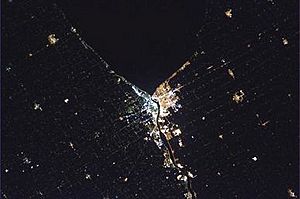
Sarnia is on the eastern shore of Lake Huron. The land around it is mostly flat. The soil is mostly clay, but it is good for farming.
Sarnia's Neighbourhoods
Sarnia has many neighbourhoods. Some in the North End are Wiltshire Park and Oak Acres. Blackwell and Bright's Grove are in the northeast. South of the main highway, you can find Coronation Park and Sherwood Village.
The village of Blue Water was built for workers in Chemical Valley. In 1961, everyone living there moved to make space for more chemical plants. The village was torn down. Now, only a historical marker shows where it used to be.
Sarnia's Weather
Sarnia has a humid continental climate. Winters are cold, but not usually extremely cold. The lake helps keep temperatures milder. Sarnia sometimes gets a lot of snow from the lake.
The lake also makes the warm weather last longer after summer. But cooler temperatures can stay longer after winter. Extreme cold or hot days are rare. Summers are warm and often humid. Sarnia has many days where the humidex (how hot it feels) is very high. Thunderstorms can be strong from April to September. Very damaging weather is rare, but a tornado hit in 1953.
Who Lives in Sarnia?
| Historical populations | ||
|---|---|---|
| Year | Pop. | ±% |
| 1841 | 610 | — |
| 1871 | 2,929 | +380.2% |
| 1881 | 3,874 | +32.3% |
| 1891 | 6,692 | +72.7% |
| 1901 | 8,176 | +22.2% |
| 1911 | 9,947 | +21.7% |
| 1921 | 14,877 | +49.6% |
| 1931 | 18,191 | +22.3% |
| 1941 | 18,734 | +3.0% |
| 1951 | 34,697 | +85.2% |
| 1961 | 50,976 | +46.9% |
| 1971 | 57,644 | +13.1% |
| 1981 | 50,829 | −11.8% |
| 1991 | 74,167 | +45.9% |
| 1996 | 72,738 | −1.9% |
| 2001 | 70,876 | −2.6% |
| 2006 | 71,419 | +0.8% |
| 2011 | 72,366 | +1.3% |
| 2016 | 71,594 | −1.1% |
| 2021 | 72,047 | +0.6% |
Population figures reflect Sarnia's amalgamation with Clearwater in 1991. |
||
In 2021, Sarnia had about 72,047 people living in 32,188 homes. The city's population density was about 439.6 people per square kilometre.
Most people in Sarnia (86.2%) are White. About 8.3% are visible minorities, and 5.5% are Indigenous. The largest visible minority groups are South Asians (2.7%), Black Canadians (1.6%), and Latin Americans (0.9%).
In 2021, 87.5% of Sarnians spoke English as their first language. About 2.2% spoke French. Another 3.4% spoke a different language.
The average age in Sarnia is 46.0 years old. This is older than the Canadian average of 41.6. This shows that Sarnia has an aging population.
In 2021, most residents (56.8%) were Christian. About 39.5% said they had no religion. Other religions made up 3.6% of residents.
The average income for people over 15 in Sarnia was $33,833 in 2015. The average family income was $86,654. The average price of a house in Sarnia in 2021 was $430,000.
Sarnia's Economy: How People Make a Living
The main parts of Sarnia's economy are the chemical industry and farming. Even though jobs in these areas have gone down, they are still very important.
During World War II, Sarnia was chosen to make synthetic rubber. This rubber was made from petroleum. Large pipelines bring oil from Alberta to Sarnia. Oil refining and making petrochemicals are key to Sarnia's economy. Companies like Shell Canada and Imperial Oil have refineries here.
Large salt beds under the city provide salt. This salt is used to make chlorine and other important ingredients for the chemical industry. Chemical companies like NOVA Chemicals and Bayer also operate in Sarnia.
Dow Chemical stopped its operations in Sarnia in 2009. The land was sold to TransAlta Energy Corporation. TransAlta makes power and steam for industries. They have created the Bluewater Energy Park on the old Dow site. Dow Chemical returned to Sarnia in 2019.
Lanxess makes a lot of butyl rubber in Sarnia. This rubber is used in many products, including chewing gum. Lanxess has also created the Bio-industrial Park Sarnia.
Chemical Valley has 62 industrial facilities and refineries. These are very important to Sarnia's economy. They employ almost 8,000 people directly. They also support about 45,000 other jobs in the area. In 1971, the Canadian government even put a picture of a Sarnia oil refinery on the $10 bill.
This large industrial area causes some air and water pollution. About 45% of the tiny particle air pollution in Sarnia comes from Chemical Valley. The rest comes from the United States, drifting over the St. Clair River.
Sarnia is also home to the Enbridge Sarnia Photovoltaic Power Plant. This solar power plant opened in 2009. In 2010, it was the largest photovoltaic solar power plant in the world.
The Western University Research Park, Sarnia-Lambton Campus, was started in 2003. It is a joint effort with the County of Lambton and the City of Sarnia. This park is also home to the Bioindustrial Innovation Centre. This centre helps new industrial biotechnology ideas become real products.
In 2015, BioAmber opened a plant that makes succinic acid. This chemical is used in plastics, paints, and cosmetics. Other companies are also working on new technologies in Sarnia.
Shopping and Places to Stay
Sarnia has one large mall called Lambton Mall. It has 72 stores. This mall and other smaller shopping centres are the main places to shop. There are also many hotels in the city.
Arts, Culture, and Fun in Sarnia
Music, Theatre, and Art
The International Symphony Orchestra performs at the Imperial Theatre. They have concerts from September to April. The Imperial Theatre also has plays all year round. Famous musicians like Kim Mitchell have played concerts in Sarnia.
Sarnia used to have the Sarnia Bayfest. This was a big music festival with famous rock and country bands. Bands like Aerosmith and KISS played there. It stopped in 2013 due to money problems. In 2017, a new festival called Bluewater Borderfest started.
Sarnia has several museums that tell its history. This includes its story as the home of the North American oil industry. Gallery Lambton has 12 art shows each year. In 2012, the Judith and Norman Alex Art Gallery opened. It shows Canadian art history, including paintings from the Group of Seven.
The South Western International Film Festival started in Sarnia in 2015. It takes place at the Imperial Theatre.
During Christmas, Sarnia has the "Celebration of Lights" in Centennial Park. This event started in 1984. It has won many awards. It is now run by a group of volunteers.
Cool Places to Visit in Sarnia
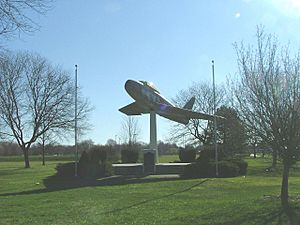
Sarnia has over 100 parks. The biggest is Canatara Park. It covers more than 200 acres along Lake Huron. "Canatara" means Blue Water in the Ojibwe language. The park opened in 1933.
Inside Canatara Park is Lake Chipican. Many different birds stop here during their migrations. Birdwatchers often see about 150 species each year. The park also has a Children's Animal Farm. The "Christmas on the Farm" event in December is very popular for families. Canatara Park also has outdoor fitness equipment.
Germain Park is Sarnia's largest sports park. It has baseball fields, soccer fields, and an outdoor pool. A Canadair Sabre jet is on display in the park. It is a memorial to Canadian pilots who died in World War II.
Centennial Park opened in 1967 for Canada's 100th birthday. In 2013, parts of the park were closed because of lead and asbestos in the soil. After cleaning, the park reopened in 2017.
The Howard Watson Trail is an old railway line. It is now a park that goes through city and country areas. This 16 km path has wooded areas and ponds. You can bike, run, or walk dogs here. In winter, you can snowshoe or cross-country ski.
Sarnia is connected to the Great Lakes Waterfront Trail. This trail is over 2,100 km long. It goes along the Canadian shores of Lake Ontario, Lake Erie, Lake Huron, and other rivers. It connects 114 communities and many parks and beaches.
Sarnia has a museum called "Stones 'N Bones." It has over 6,000 exhibits. These include rocks, fossils, and bones from around the world.
The city's sandy beaches are popular for tourists. The harbour has marinas for recreational sailing. Since 1925, the 400 km Mackinac race has been a highlight of the sailing season. Over 3,000 sailors take part each year.
Sarnia's fresh-cut potato fries are also a popular attraction. Many visitors go to the chip trucks under the Blue Water Bridge.
Sports in Sarnia
Sarnia is home to the Sarnia Sting. This is a junior ice hockey team in the Ontario Hockey League. Famous NHL players like Steven Stamkos and Nail Yakupov played for the Sting. Sarnia also has the Sarnia Legionnaires hockey team. They play in the Greater Ontario Junior Hockey League.
Sarnia has a strong history in Canadian football. The Sarnia Imperials football team won the Grey Cup twice, in 1934 and 1936. Today, there is a semi-professional team called the Sarnia Imperials.
Mike Ceresia from Sarnia won four world championships in racquetball. Steve Bice, a world champion curler from Sarnia, also won two major curling championships.
Getting Around Sarnia
Transportation
The Blue Water Bridge connects Sarnia to Port Huron in the United States. It crosses the St. Clair River. The first part of the bridge opened in 1938. A second part opened in 1997. It is now the fourth-busiest border crossing in Ontario.
The Blue Water Bridge is part of the NAFTA Superhighway. It is a very important route for trucks going north and south.
Sarnia Transit provides public bus transportation within Sarnia. The city's local Sarnia Chris Hadfield Airport used to have flights to Toronto. For train travel, Sarnia is one end of the Via Rail Quebec City – Windsor Corridor. Trains leave Sarnia station in the morning and return in the evening.
Learning in Sarnia
The Lambton Kent District School Board runs 13 elementary schools and three high schools in Sarnia. These high schools are Northern Collegiate, Alexander MacKenzie, and Great Lakes Secondary School.
The St. Clair Catholic District School Board runs seven elementary Catholic schools and one Catholic high school, St. Patrick's.
There are also French Catholic schools and French public schools in Sarnia. Two independent Christian elementary schools are Sarnia Christian School and Temple Christian Academy.
Lambton College is Sarnia's only post-secondary school. It offers two and three-year programs. About 3,500 students attend full-time.
News and Media in Sarnia
Four radio stations broadcast from Sarnia. Other stations also send their signals there. These include a First Nations station and CBC Radio stations.
- CHOK (1070 AM) plays country music and has news and sports.
- CFGX-FM The Fox (99.9 FM) plays adult contemporary music.
- CHOK-1-FM (103.9 FM) is a rebroadcaster of CHOK AM.
- CHKS-FM (106.3 FM) plays classic hits.
Sarnia's main daily newspaper is the Sarnia Observer. Other local publications include Sarnia This Week and Business Trends. There is also an online news website called lambtonshield.com. Two magazines, Business Trends and Report on Industry, are published in Sarnia.
Famous People from Sarnia
See also
 In Spanish: Sarnia para niños
In Spanish: Sarnia para niños



